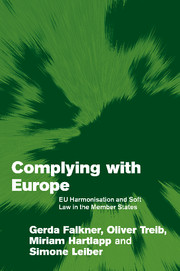Book contents
- Front matter
- Contents
- List of figures
- List of tables
- Preface
- 1 Introduction: flexible EU governance in domestic practice
- 2 Theorising the domestic impact of EU law: the state of the art and beyond
- 3 EU social policy over time: the role of Directives
- 4 The Employment Contract Information Directive: a small but useful social complement to the internal market
- 5 The Pregnant Workers Directive: European social policy between protection and employability
- 6 The Working Time Directive: European standards taken hostage by domestic politics
- 7 The Young Workers Directive: a safety net with holes
- 8 The Parental Leave Directive: compulsory policy innovation and voluntary over-implementation
- 9 The Part-time Work Directive: a facilitator of national reforms
- 10 Voluntary reforms triggered by the Directives
- 11 The EU Commission and (non-)compliance in the member states
- 12 Beyond policy change: convergence of national public–private relations?
- 13 Implementation across countries and Directives
- 14 Why do member states fail to comply? Testing the hypotheses suggested in the literature
- 15 Three worlds of compliance: a typology
- 16 Conclusions: myth and reality of social Europe
- References
- Index
10 - Voluntary reforms triggered by the Directives
Published online by Cambridge University Press: 22 September 2009
- Front matter
- Contents
- List of figures
- List of tables
- Preface
- 1 Introduction: flexible EU governance in domestic practice
- 2 Theorising the domestic impact of EU law: the state of the art and beyond
- 3 EU social policy over time: the role of Directives
- 4 The Employment Contract Information Directive: a small but useful social complement to the internal market
- 5 The Pregnant Workers Directive: European social policy between protection and employability
- 6 The Working Time Directive: European standards taken hostage by domestic politics
- 7 The Young Workers Directive: a safety net with holes
- 8 The Parental Leave Directive: compulsory policy innovation and voluntary over-implementation
- 9 The Part-time Work Directive: a facilitator of national reforms
- 10 Voluntary reforms triggered by the Directives
- 11 The EU Commission and (non-)compliance in the member states
- 12 Beyond policy change: convergence of national public–private relations?
- 13 Implementation across countries and Directives
- 14 Why do member states fail to comply? Testing the hypotheses suggested in the literature
- 15 Three worlds of compliance: a typology
- 16 Conclusions: myth and reality of social Europe
- References
- Index
Summary
The preceding chapters have dealt with the compulsory reforms related to our six EU Directives. However, the domestic impact of EU policies is not necessarily confined to such obligatory adaptations. Member states may use the transposition process to push through voluntary reforms that go beyond the minimum level required by European Directives. On the one hand, this can be a reaction to European soft law and, in fact, recent social policy Directives have included a considerable number of concrete but legally non-binding recommendations. On the other hand, member states might also decide to surpass the level of the EU's minimum standards (say, by creating a parental leave scheme which offers six instead of the required three months of leave).
From an abstract point of view, three different logics of treating the binding and non-binding parts of a Directive can be specified: minimalism, maximalism and alogic of domestic politics (see Table 10.1). The most frequently discussed assumption in the competitiveness-oriented literature is that the reaction of member states to potentially costly EU policies is driven by a logic of minimalism. According to this view, only binding law has the potential to harmonise the different domestic working conditions. In the absence of obligation, no additional costs to the national enterprises or the administration would be accepted in response to European policies.
- Type
- Chapter
- Information
- Complying with EuropeEU Harmonisation and Soft Law in the Member States, pp. 178 - 200Publisher: Cambridge University PressPrint publication year: 2005

